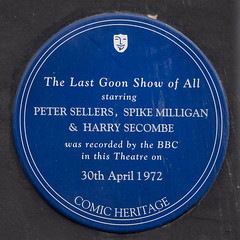The Goon Show
Commemorated on 2 plaques
The Last Goon Show of All starring Peter Sellers, Spike Milligan & Harry Secombe was recorded by the BBC in this Theatre on 30th April 1972
KOKO, Chalk Farm Road, London, United Kingdom where it recorded (1972)
The Goon Show 1951-1960 first exploded here
The Strutton Arms, 2 Strutton Ground, SW1P 2HP, London, United Kingdom where it first exploded (1951)


